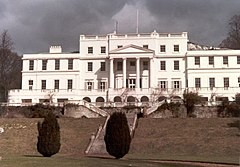Linton Park
| Linton Park | |
|---|---|

Linton Park house from the south
|
|
|
Location within Kent
|
|
| General information | |
| Town or city | Linton |
| Country | England |
| Coordinates | 51°13′18″N 0°30′58″E / 51.221739°N 0.516051°E |
Linton Park, formerly Linton Place or Linton Hall, is a large 18th-century country house in Linton, Kent, England. Built by Robert Mann in 1730 to replace an earlier building, the house and estate passed through the ownership of several members of Mann's family before coming into the Cornwallis family. The house was enlarged to its current size in 1825.
The house sits in a prominent location, part way down a south-facing slope which provides excellent views of the grounds and the Weald beyond. Gardens close to the house contain formal walks laid out in 1825 with specimen trees planted then and later.
The house is a Grade I listed building and the garden and park is listed Grade II*. Other buildings and structures in the park are also listed.
Linton Park is now the corporate headquarters of Camellia plc, an international agricultural company.
From the late 14th century, a house by the name of Capell's Court stood on the site of Linton Park. It took its name from a family of local landowners named de Capell who held the property from the late 14th century to the mid-15th century. It was then sold to the Baysden family who held it until the late 16th century, when it was sold to Sir Anthony Mayney. Mayney's grandson sold the estate to the judge Sir Francis Wythen. Wythen's daughter, Catherine, inherited the estate and, following her second marriage to Brigadier-General Sir George Jocelyn, the estate was sold to London merchant Sir Robert Mann.
Around 1730, Mann demolished Capell's Court and built the first part of the present house. On his death in 1751, the house passed to his son Edward Mann. Edward Mann died in 1775 without children and the house passed to his brother the diplomat Sir Horace Mann. Sir Horace had taken the name of the estate as his territorial designation when made a baronet in 1755, but was permanently resident in Florence. Sir Horace Mann was a friend and long-time correspondent of Horace Walpole. After a visit to Edward Mann at Linton Park in 1757, Walpole wrote to Sir Horace in Florence that: "the house is fine and stands like the citadel of Kent; the whole county is its garden." On the death of Sir Horace in 1786, the baronetcy and the house passed to his nephew, Sir Horatio Mann MP, of Boughton Place in nearby Boughton Malherbe.
...
Wikipedia

